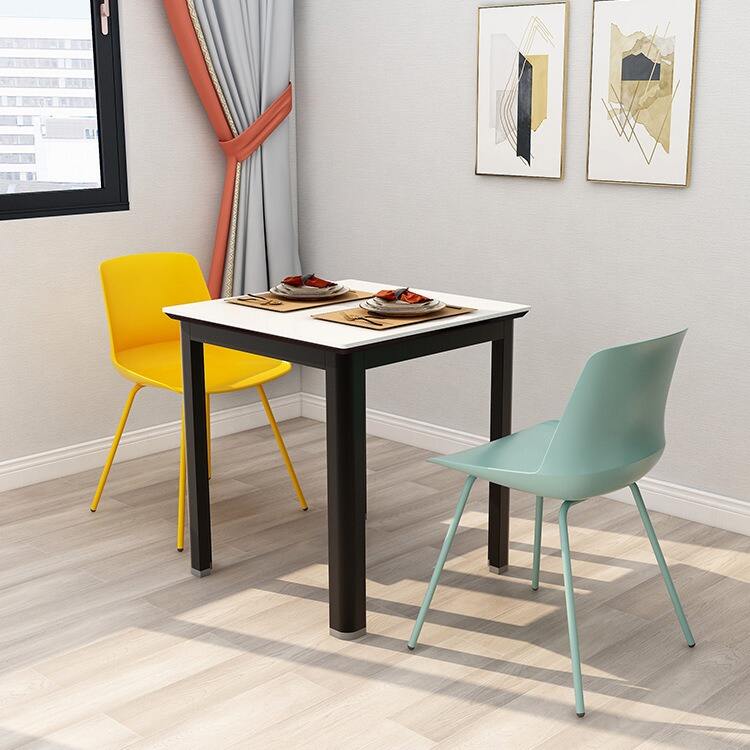Δημιουργώντας Ατμόσφαιρα μέσω Προσεκτικής Επιλογής Έπιπλων
Η τραπεζαρία χρησιμεύει σε περισσότερα πράγματα από το να μοιράζεστε γεύματα - είναι εκεί που δημιουργούνται μνήμες, οι συνομιλίες ρέουν ελεύθερα και οι σχέσεις ενδυναμώνονται κοντά σε νόστιμο φαγητό και ζεστή παρέα. Τα έπιπλα τραπεζαρίας που επιλέγετε έχουν καθοριστικό ρόλο στη διαμόρφωση της ατμόσφαιρας και στη διαδικασία σχηματισμού αυτών των εμπειριών. Από πολύτιμες οικογενειακές συναθροίσεις μέχρι γιορταστικές εκδηλώσεις, η επιλογή σας σε στοιχεία έπιπλων επηρεάζει άμεσα το πώς οι άνθρωποι αισθάνονται και αλληλεπιδρούν μέσα στον χώρο.
Η κατανόηση της ψυχολογίας πίσω από την επιλογή έπιπλων μπορεί να μεταμορφώσει τον χώρο της τραπεζαρίας σας από έναν απλό χώρο φαγητού σε έναν προσφιλή θάλαμο που προάγει τη σύνδεση και την άνεση. Ο σωστός συνδυασμός κομματιών μπορεί να δημιουργήσει μια ατμόσφαιρα που ταιριάζει τέλεια στον τρόπο ζωής και στην επιθυμητή αίσθηση που επιθυμείτε.
Η βάση του σχεδιασμού τραπεζαρίας
Σχήματα τραπεζιών και η επίδρασή τους
Στην καρδιά κάθε χώρου τραπεζαρίας βρίσκεται το τραπέζι - το κεντρικό σημείο που οριοθετεί ολόκληρο τον χώρο. Τα στρογγυλά τραπέζια προάγουν την ισότητη και την εύκολη επικοινωνία, καθιστώντας τα ιδανικά για οικείες συναθροίσεις και μικρότερους χώρους. Οι ελαφριές τους γωνίες δημιουργούν μια φιλόξενη ατμόσφαιρα που προτρέπει την αλληλεπίδραση μεταξύ όλων των καλεσμένων. Τα ορθογώνια τραπέζια, τα οποία είναι παραδοσιακά η πιο συνηθισμένη επιλογή στα έπιπλα τραπεζαρίας, προσφέρουν ξεκάθαρες οπτικές γραμμές και μια τυπική διάταξη που λειτουργεί καλά για μεγαλύτερες συναθροίσεις.
Το υλικό της τραπεζαρίας σας μιλάει επίσης για το χαρακτήρα του δωματίου. Οι πλούσιες ξύλινες τραπεζαρίες εμφανίζουν θερμασία και παράδοση, ενώ οι τραπεζαρίες με επιφάνεια από γυαλί προσφέρουν σύγχρονη ευγενική αισθητική και οπτική ελαφρότητα. Οι μεταλλικές τραπεζαρίες και αυτές με βιομηχανικό στυλ μπορούν να προσθέσουν μια αστική ακμή, ιδανική για σύγχρονους χώρους τραπεζαρίας.
Λύσεις Καθιστικών Που Καθορίζουν τον Τόνο
Τα καθίσματα είναι περισσότερα από απλά λειτουργικά κομμάτια - είναι αποφασιστικά στοιχεία που συμβάλλουν τόσο στην άνεση όσο και στο στυλ. Τα καθίσματα με ψηλή πλάτη δημιουργούν αίσθηση τυπικότητας και μεγαλοπρέπειας, ενώ τα χαμηλά καθίσματα προσφέρουν πιο επίπλαστη και χαλαρή ατμόσφαιρα. Η εισαγωγή καθισμάτων τραπεζαρίας με υφασμάτινη επένδυση μπορεί να μαλακώσει την ακουστική του δωματίου, προσθέτοντας στρώσεις υφής και χρώματος στη διαρρύθμιση των έπιπλων της τραπεζαρίας σας.
Σκεφτείτε να αναμείξετε στυλ καρεκλών για ένα ετερόκλητο αλλά ενοποιημένο αποτέλεσμα. Συνδυάζοντας έναν πάγκο στη μία πλευρά της τραπεζαρίας με μεμονωμένες καρέκλες δημιουργείται ένας ενδιαφέρων δυναμισμός, ο οποίος μπορεί να προσαρμοστεί εύκολα σε διαφορετικό αριθμό καλεσμένων. Το κλειδί είναι να βρεθεί το σωστό μέτρο ανάμεσα στην άνεση και την αισθητική έλξη.
Η ψυχολογία των χρωμάτων στους χώρους γευμάτων
Ζεστά έναντι δροσερών τόνων
Η παλέτα χρωμάτων των έπιπλων της τραπεζαρίας επηρεάζει σημαντικά την εμπειρία του γεύματος. Τα ζεστά ξύλα και οι πλούσιοι γήινοι τόνοι διεγείρουν την όρεξη και δημιουργούν ένα ζεστό, οικείο κλίμα, ιδανικό για οικογενειακές συγκεντρώσεις και πολύχρονη άνεση. Αντιθέτως, οι δροσεροί τόνοι, όπως τα γκρι και τα λευκά, δημιουργούν έναν εξεζητημένο, σύγχρονο ατμόσφαιρα, ιδανική για τυπικές εκδηλώσεις.
Σκεφτείτε πώς οι διαφορετικές επιστρώσεις ξύλου επηρεάζουν τη διάθεση του δωματίου. Τα σκούρα μαχόγυαλα ή τα έπιπλα από καρυδιά φαίνονται πιο τυπικά και παραδοσιακά, ενώ τα ελαφρύτερα έπιπλα από δρυ ή έλατο δημιουργούν πιο χαλαρή και σύγχρονη ατμόσφαιρα. Η επίστρωση των έπιπλων του χώρου της τραπεζαρίας μπορεί να συγκρατήσει τον χώρο ή να τον κάνει να φαίνεται πιο ανοιχτός και αερικός.
Επιτονιστικά Χρώματα και Επιδράσεις
Η στοχευμένη χρήση χρώματος μέσω της επένδυσης των επίπλων, μαξιλαριών στις καρέκλες ή βαμμένων επιφανειών μπορεί να αλλάξει δραστικά την ενέργεια του χώρου. Τα ερυθρά τόνια μπορούν να διεγείρουν τη συνομιλία και την όρεξη, καθιστώντας τα εξαιρετικές επιλογές για κοινωνικούς χώρους δείπνου. Οι μπλε αποχρώσεις προάγουν την ηρεμία και μπορούν να βοηθήσουν στη δημιουργία πιο χαλαρής ατμόσφαιρας στο χώρο της τραπεζαρίας, ενώ οι πράσινες αποχρώσεις φέρνουν ένα φυσικό, αναζωογονητικό στοιχείο στον χώρο.
Μη διστάσετε να ενσωματώσετε πολλαπλά χρώματα μέσω της επιλογής των έπιπλων της τραπεζαρίας σας, αλλά διατηρήστε ένα συνοχές θέμα για να αποφύγετε το οπτικό χάος. Σκεφτείτε να χρησιμοποιήσετε έναν τροχό χρωμάτων για να επιλέξετε συμπληρωματικά ή ανάλογα χρώματα που να συνδυάζονται αρμονικά μεταξύ τους.
Θεωρήσεις Κλίμακας και Αναλογίας
Χωρική Ισορροπία στη Διάταξη Επίπλων
Το μέγεθος και η κλίμακα των επίπλων της αίθουσας υποδοχής πρέπει να ληφθούν προσεκτικά υπόψη για να δημιουργηθεί ένας ισορροπημένος και λειτουργικός χώρος. Ένας πολύ μεγάλος πίνακας μπορεί να κατακλύζει ένα μικρό δωμάτιο, ενώ επιπλα μικρού μεγέθους μπορούν να κάνουν ένα ευρύχωρο δωμάτιο να νιώθει άδειο και απωθητικό. Ο γενικός κανόνας είναι να αφήνετε τουλάχιστον 36 ίντσες ελεύθερο χώρο γύρω από το τραπέζι για άνετη κίνηση και τοποθέτηση καθισμάτων.
Λάβετε υπόψη το οπτικό βάρος των διαφορετικών κομματιών και τον τρόπο με τον οποίο συνδυάζονται μεταξύ τους. Ένας σημαντικός πίνακας ίσως να συνδυαστεί καλά με πιο ελαφριές, τρανταχτές καρέκλες για να διατηρηθεί η ισορροπία. Ομοίως, ένας γυάλινος πίνακας θα μπορούσε να συμπληρωθεί από πιο ογκώδη καθίσματα για να δημιουργηθεί οπτικό ενδιαφέρον και σταθερότητα.
Λύσεις Αποθήκευσης και Επιπλέον Κομμάτια
Τα κομμάτια έπιπλα υποστήριξης, όπως οι παραπετάσματα, τα μπουφέ και οι ντουλάπες για πορσελάνη συμβάλλουν σημαντικά στη λειτουργικότητα και τη διάθεση του δωματίου. Αυτά τα κομμάτια έπιπλα της αίθουσας διατροφής θα πρέπει να συμπληρώνουν το κυρίως τραπέζι ενώ παρέχουν απαραίτητη αποθήκευση και χώρο έκθεσης. Η τοποθέτησή τους μπορεί να βοηθήσει στον καθορισμό των ορίων του δωματίου και στη δημιουργία φυσικών προτύπων ροής.
Κατά την επιλογή επιπλέον έπιπλα, να λαμβάνετε υπόψη τόσο τις πρακτικές ανάγκες όσο και την αισθητική επίδραση. Ένα όμορφο ντουλάπι μπορεί να λειτουργεί ως εστία ενδιαφέροντος ενώ φυλάσσει τα τραπεζομάντηλα, ενώ ένας στρατηγικά τοποθετημένος καροτσάκις μπορεί να προσθέσει ευκολία χωρίς να δημιουργεί αχαρτοσύνη στον χώρο.
Ολοκλήρωση Φωτισμού με Έπιπλα
Αλληλεπίδραση Φυσικού Φωτός
Η σχέση ανάμεσα στα έπιπλα της αίθουσας υποδοχής σας και τις φυσικές πηγές φωτός μπορεί να επηρεάσει σημαντικά την ατμόσφαιρα του δωματίου. Ανακλαστικές επιφάνειες, όπως το γυαλί ή το λειασμένο ξύλο, μπορούν να βοηθήσουν στην ανάκλαση του φωτός σε όλο το δωμάτιο, κάνοντας το να φαίνεται πιο ευρύχωρο και αερικό. Σκεφτείτε πώς διαφορετικά τελειώματα φαίνονται υπό διαφορετικές συνθήκες φωτισμού καθ' όλη τη διάρκεια της ημέρας.
Τοποθετήστε το τραπέζι σας με τρόπο ώστε να εκμεταλλεύεστε το φυσικό φως, αποφεύγοντας όμως την εξάρσεις της λάμψης κατά τη διάρκεια των ωρών με την περισσότερη χρήση. Έπιπλα ανοιχτόχρωμα μπορούν να φωτίσουν ένα σκοτεινό δωμάτιο, ενώ πιο σκούρα κομμάτια μπορούν να προσθέσουν δραματικότητα και σοφιστικέ σε ένα καλά φωτισμένο χώρο.
Συντονισμός Τεχνητού Φωτισμού
Η επιλογή σας για έπιπλα στην αίθουσα υποδοχής πρέπει να λειτουργεί εν αρμονία με τα φωτιστικά σας. Ένα μεγάλο πολυέλαιο πάνω από ένα απλό τραπέζι μπορεί να φαίνεται αναλογικά υπερβολικό, ενώ ένας ανεπαρκής φωτισμός μπορεί να μειώσει την επίδραση όμορφων επίπλων. Σκεφτείτε πώς διαφορετικά υλικά και τελειώματα φαίνονται υπό διαφορετικές συνθήκες φωτισμού.
Διατάξτε το φωτισμό σας για να δημιουργήσετε διαφορετικές διαθέσεις για διάφορες περιπτώσεις. Ένας συνδυασμός φωτισμού περιβάλλοντος, εργασίας και φωτισμού τονισμού μπορεί να τονίσει τα καλύτερα χαρακτηριστικά των έπιπλών σας, ενώ δημιουργεί την επιθυμητή ατμόσφαιρα για κάθε γευματική εμπειρία.
Συχνές Ερωτήσεις
Ποιο μέγεθος τραπεζιού φαγητού πρέπει να επιλέξω για τον χώρο μου;
Το ιδανικό μέγεθος τραπεζιού εξαρτάται από τις διαστάσεις του δωματίου σας και τις συνήθεις ανάγκες σας στο φαγητό. Να επιτρέπετε 24 ίντσες πλάτους τραπεζιού ανά άτομο και να διατηρείτε τουλάχιστον 36 ίντσες ελεύθερο χώρο γύρω από το τραπέζι. Για βέλτιστη άνεση και ευελιξία, επιλέξτε ένα τραπέζι που επιτρέπει άνετη τοποθέτηση καθισμάτων, αφήνοντας αρκετό χώρο για κίνηση γύρω από τον χώρο της τραπεζαρίας.
Πώς μπορώ να συνδυάσω με επιτυχία διαφορετικούς στυλ έπιπλα τραπεζαρίας;
Για να μπορέσετε να αναμείξετε με επιτυχία διαφορετικούς στυλ έπιπλων, διατηρήστε ένα κοινό στοιχείο σε όλα τα κομμάτια - αυτό μπορεί να είναι το χρώμα, το υλικό ή η κλίμακα. Επικεντρωθείτε στη δημιουργία ισορροπίας αντί για τέλεια αντιστοιχία. Για παράδειγμα, συνδυάστε ένα σύγχρονο τραπέζι με παραδοσιακές καρέκλες σε συμπληρωματικές απολήξεις, ή αναμείξτε στυλ καρεκλών διατηρώντας το υλικό της επένδυσης συνεπές.
Ποια υλικά είναι καλύτερα για τραπεζαρίες με υψηλή επισκεψιμότητα;
Για περιοχές τραπεζαρίας με υψηλή επισκεψιμότητα, ψάχνεστε για ανθεκτικά υλικά, όπως μασίφ ξύλο, μέταλλο ή ποιοτικά μοριόλυτα με προστατευτικές επιφάνειες. Εξετάστε τη χρήση υλικών ανθεκτικών στους λεκέδες για τα επενδυμένα κομμάτια, και επιλέξτε επιφάνειες που είναι εύκολο να καθαρίζονται και να συντηρούνται. Τα ποιοτικά έπιπλα τραπεζαρίας κατασκευασμένα από ανθεκτικά υλικά θα διατηρήσουν την εμφάνιση και τη λειτουργικότητά τους παρά την καθημερινή χρήση.


